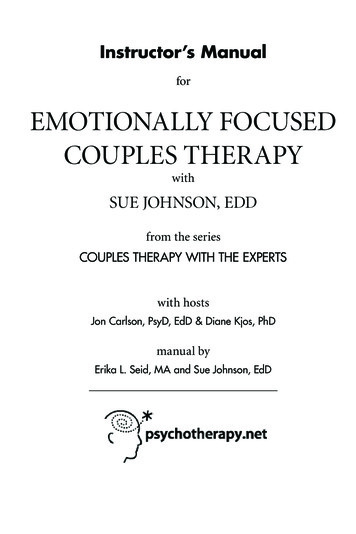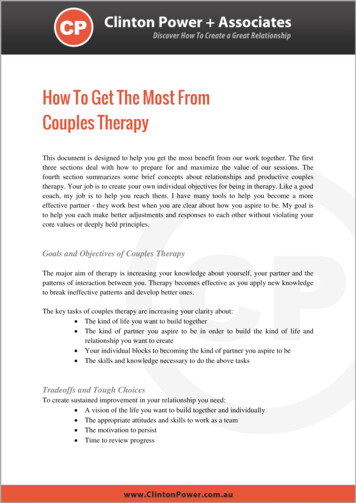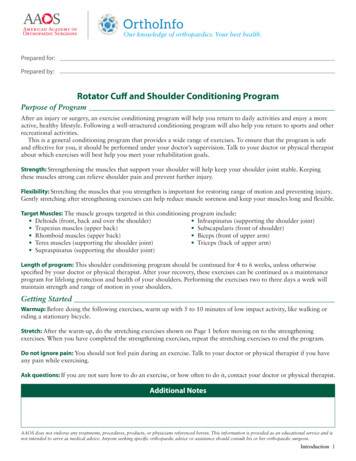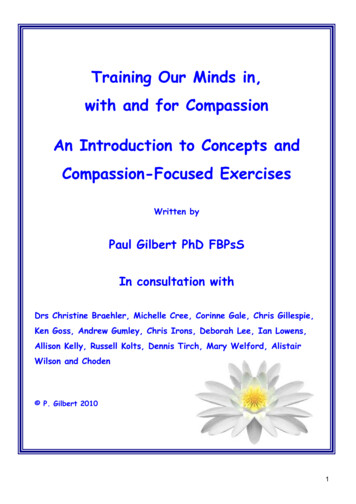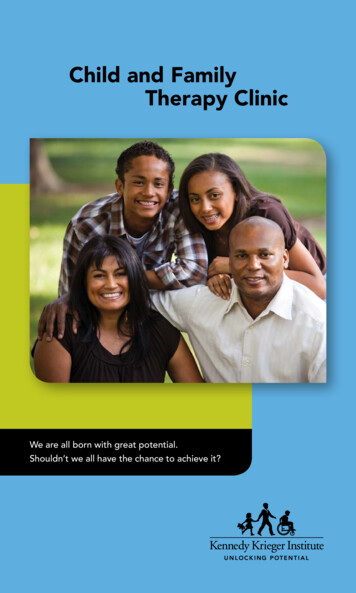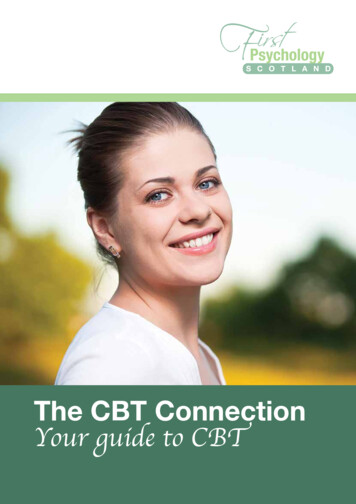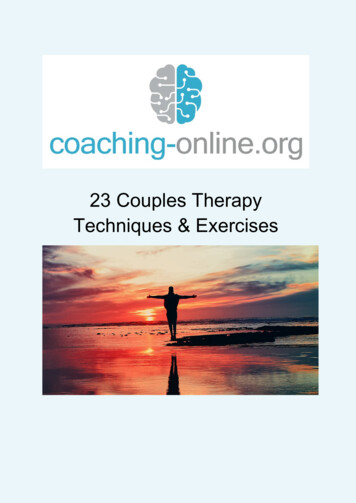
Transcription
23 Couples TherapyTechniques & Exercises
23 Couples Therapy Techniques &ExercisesNo two people see the world exactly the same way. An occasional argument can behealthy. However, if it’s frequent, it’s likely a source of stress and unhappiness.If it’s time for you to enhance your relationship, rest assured, there are a multitude ofcouples therapy techniques and exercises at your fingertips.In this article, everything you need to know about couples therapy and couples’ activities ishere. You can download the pdf to use and keep with you.1. Soul GazingFace your spouse while you’re both seated. Move so close that your knees arenearly touching, and look into each other’s eyes.Hold this eye contact for three to five minutes. It’s okay – you can blink! Although,refrain from talking. Simply look into each other’s eyes. It will seem awkward at first.Make this experience more powerful by playing a good meaningful song in terms ofyour connection while you hold eye contact until the song ends.2.The 7 Breath-Forehead Connection ExerciseBegin by either lying down on your side by your partner or sitting upright facing eachother. Gently touch your foreheads together. Tilt your chins down so you aren’tbumping noses and keep this position for a few breaths.Breathe at least seven slow, deep breaths in sync. It might be difficult at first, butyou will get the hang of it before long. If you’re both enjoying the exercise, by allmeans prolong it – take 20 breaths, or 30, or simply breathe together for a setamount of time.This close breathing exercise will put you both into an intimate, connected space.Practice it whenever you feel the need to slow down and refocus on each other.2
3.Express Gratitude And AppreciationExpressing gratitude comes from the heart and appreciation expresses how muchyou value something.Communicating these feelings in your marriage can help strengthen your bond.Be creative in finding ways of expressing these feelings daily through in-personconversations, texts, or sticky notes where your partner will see it.4.Deeper Conversation TopicsMove past surface-level conversations and ask your spouse questions other than“What’s for dinner?”Slipping into the busyness of day-to-day requirements, we don’t realize we’vestopped having conversations about deeper feelings or issues.5.Good QualitiesWorking in sync to solve your problems is a reminder why you were drawn to eachother.List on a piece of paper at least three treasured things that come to mind for eachpoint: The good qualities which first drew me to my significant other My most cherished memories of our journey together include I appreciate my partner because My partner shows me they care by6.Identify Your Partner’s Love LanguageJust because you’re in a relationship doesn’t mean you experience love in the sameway. Each person has a preferred way of receiving love.“The 5 Love Languages” by Dr. Gary Chapman has helped couples identify whatmakes them feel loved so they can learn how to show up for each other.3
7.receiving giftsacts of servicewords of affirmationquality timephysical touchSchedule Important ConversationsAre you looking to have an important or difficult discussion with your partner? Inorder to avoid conflicts because the timing is wrong, serious talks are best when youhave a plan.Schedule tough conversations in advance so not one partner or the other is caughtoff guard.8.Pencil In 1:1 TimeLife can be hectic, however, don’t let outside pressures override time with yourpartner.Schedule an hour of ‘couples time’ to be intimate for a great start. Also, schedule anhour to focus on topics to help improve the marriage.9.Fill Your Intimacy BucketFor a healthy relationship, understand that you both have intimacy needs, as acouple and individually.Consider these types of intimacy: intellectual experiential social emotional sexualFind fun activities for couples in each bucket to do. For example, you may explore anew hobby with each other or have a game night with mutual friends.4
10.Partner YogaTeam up with your partner for couples yoga.Partner yoga allows you to balance as one with your partner, establishing andstrengthening trust as you flow through tandem moves.Research from a 2016 study linked mindfulness to increased satisfaction and mentalhealth.11.Common Goals - DreamExplore the type of future you’d like to build, individually and as a couple.Sometimes our struggle can be because we don’t know what our goals actually are.Practice Imagining or dreaming in sync that overnight your life instantly improved in every way. All the problems and troubles disappeared. What would you noticethat was different? How would you BE different?Use this discussion as an opportunity to learn something new about your partnerand plan for your future together.12.Engaged ListeningEngaged listening allows you to feel heard, understood, and cared for.Set a timer for three to five minutes and let your partner talk. Whatever is on theirmind – work, school, you, the kids, friends or family, stress – is fair game.Your job is to do one thing: listen. Don’t speak at all until the timer goes off. Simplysoak it all in. You’re free to give your partner non-verbal encouragement or empathythrough body language, facial expressions, or meaningful looks.When the timer goes off, switch roles.5
13.Extended Cuddle TimeThis exercise is just as simple—and fun—as it sounds! The instructions are simplyto cuddle more often. Cuddling causes your body to release oxytocin and reducescortisol, the stress hormone.Right before bed is best, but you can carve out any time of the day to cuddle. Theimportant thing is to get some one-on-one time, show physical affection, andenhance affection with your partner.14.Start A Book Club For TwoYou can share an experience at your own pace. Alternate the responsibility ofchoosing a book that’s grabbed your attention, and set a date to discuss it overdinner.15.Connect With MusicFeel nostalgia for the days of making your school crush the ultimate mixtape.Curate your own playlist of songs that remind you of your partner and the momentsyou’ve shared. Swap your playlists and get a peek into each other’s romantic side.16.Icebreaker QuestionsJust like icebreakers from summer camp or work seminars, this conversationstarting game may help reinvigorate your marriage and teach you something newabout your partner.Set time aside to discuss icebreaker questions that dig beneath the surface.17.Share A List Of Things You Want From Your PartnerShare three things your partner could do weekly that would make you happy. Shareyour list with one another while looking into each other’s eyes.This reminder of things they can do once a week will help build trust andcommunication.6
18.Show Interest In Each Other’s DayWhen was the last time you asked your partner what they were most excited aboutfor the day?Spend a few moments discussing your partner’s agenda and goals to help supportthem in feeling cared for in your relationship.19.The 6-Second KissWith the 6-second kiss, as advocated by the Gottman Institute, couples can add adash of romance seamlessly throughout the day.The kiss is long enough to be passionate while also acting as a distraction from thebusyness of the day.20.Get CraftyA vision board can help remind you of your shared desires and goals.Write down your goals and collect pictures that embody your relationship desires.Marriage, like any relationship, is a work in progress. It takes hard work and time onboth ends to create a strong, healthy, and long lasting relationship.21.Talk About Childhood MemoriesBeneath our defenses, we all have a scared child we're still trying to protect. Thestruggles we play out in relationships often have their origin in our childhoods.Talking to each other about your experiences growing up will help foster deeperunderstanding, empathy, and emotional affection between you.22.Do Something That Scares YouTalking to your spouse about your fears—in the relationship or in general—increases your emotional confidence.7
If there's something you're both afraid of that's relatively safe to try, doing it togetherwill create a vulnerable experience you can process with one another afterward,increasing your emotional intimacy.23.Dig Deeper - Find Out Why You're Really FightingPast experiences can cause you to translate words or actions into something younever meant.There’s something more vulnerable underneath what we claim to be fighting about.For example, fights about doing the dishes can be rooted in feeling invisible orunloved.Be vulnerable enough to share your feelings to create space for exploring whatactually happened and to start unlinking concrete events from these painfulsubjective interpretations.When you practice the activities in this article properly, these couples therapy exercises canhave demonstrably positive effects.What Is The Best Therapy For Couples?Couples therapy is an important tool for couples dealing with communication problems,marital trouble, or who just want to discuss big topic issues in a therapeutic environment.Once you decide to try couples counseling, the next step is to research information on thebest type of couples counseling for you.You may need a therapist that dovetails well with your unique needs. Most therapists areversed in a variety of counseling techniques. It’s rare that a therapist exclusively adheres toa single approach.Here in this article, you’ll find a summary of couples counseling: Emotionally Focused TherapyEmotionally Focused Therapy or EFT aims to provide a better understanding ofwhat drives our emotional responses.EFT usually entails a lot of conversation about the deeper meaning of emotions.8
Rather than thinking he or she is angry just because you didn’t take out thegarbage, EFT helps to keep you emotionally focused and reframe yourunderstanding of the deeper meaning of that anger. Imago Relationship TherapyImago practitioners believe our relationship with our parents informs our adultconnections.So couples counseling is based on the connection between formative childhoodexperiences of adult family members with our adult relationships. Imago, in Latin,means image.With an Imago therapist, expect a lot of conversation during sessions and a lot ofemphasis on listening. Narrative TherapyThe spotlight here is on the stories individuals use to understand their world. We tellourselves stories about ourselves and others. Those stories guide our behavior anddecisions.Overly negative narratives, for example, can foster self-defeating attitudes and spurbad decisions.Narrative couples therapists then help them try to write new stories if needed. Solution Focused TherapyIt might not be an ideal couple therapy for wide-reaching problems in therelationship.However, the solution-oriented conversations at the heart of SFT can have goodresults for couples who need help bridging a narrowly-defined difficult situationthey’re facing. It can be very empowering. Cognitive Behavioral Therapy9
This is a common form of therapy for individuals, couples, or family therapy, whichfocuses on how our thoughts influence our behaviors.If you can understand and change negative thoughts, you can also change how youfeel and how you act.It’s about building behavioral skills, like communication, problem solving, and allowsways for the couple to remain connected to one another. Relational Life TherapyThis couple therapy is based on the influence traditional gender roles have onintimate connections.Our culture, for example, has created an environment that does not graciously allowmen to create intimate closeness and be in touch with their feelings and theiremotions.A traditional perception of masculinity can impede men’s ability to be connected andintimate with their partners. Discernment CounselingDiscernment counseling can be viewed as couples counseling of last resort whether they should split up or stay together.It’s a short term therapy, lasting five sessions or less. It’s meant to help couplesconsider all the options before they make a decision to work on it or terminate arelationship.What Is Gottman Method Couples Therapy?Doctors John Gottman and his wife Julie developed nine components of healthyinteractions known as the Sound Relationship House Theory.The goals are to disarm marital conflict in verbal communication; increase intimateconnection, respect, and affection; remove barriers that create a feeling of stagnancy; andcreate a heightened sense of empathy and understanding within the context of therelationship.10
AssessmentTreatment begins with a joint session, followed by individual interviews with eachperson. Couples complete questionnaires and then receive detailed feedback ontheir relationship. Therapeutic FrameworkThe couple and therapist decide on the frequency and duration of the treatmentsessions. Therapeutic InterventionsTreatment interventions are designed to help partners strengthen their connectionsin three primary areas: friendship, conflict management, and creation of sharedmeaning.People learn to replace negative conflict patterns with positive interactions andrepair past hurts with specific techniques.Interventions, designed to increase closeness and intimacy, are used to improvefriendship, deepen emotional connection, and create changes which enhance thepartners shared goals. Relapse prevention is also addressed.The Gottman Method is designed to support people across all economic, racial, sexualorientation, and cultural sectors.What Questions Are Asked In Couples Therapy?The therapist will facilitate conversation between each spouse. They do this by asking aseries of questions and allowing you to open up about an important topic or conflict.Here are some questions to expect: What problems are you experiencing in this relationship? Do you want a divorce? Can this marital relationship be saved? Can you trust each other again? What type of love do you have for your companion? Are you satisfied with the close affection levels in this relationship? Do you see a future with one another?11
How Can Couples Therapy Be Successful?There is a secret to approaching couples therapy that can make the difference betweengetting what you need from it and failing miserably.The secret is the readiness stage. Both individuals must be ready before the wanted resultscan be achieved.Research shows that traditional marital counseling has a success rate of 70 to 80 percent.It’s clear then, that people in troubled relationships need not give up in despair if theirsituation seems bleak. By the same token, this is encouraging for people afraid of enteringlong-term relationships. Troubled relationships may be fixed.These five principles of effective therapy suggest ways people can build and maintainpositive close relationships: Take an objective look at your marriageReceive help to reduce dysfunctional behaviorsSecurity about sharing your emotionsCommunicate effectivelyEmphasize what's workingMost importantly, remember each marriage has its unique challenges and strengths.With counseling and therapy techniques, you can feel like you'll be giving yours the bestchances for survival and have healthy relationships with others around you too.12
Couples therapy is an important tool for couples dealing with communication problems, marital trouble, or who just want to discuss big topic issues in a therapeutic environment. Once you decide to try couples co
